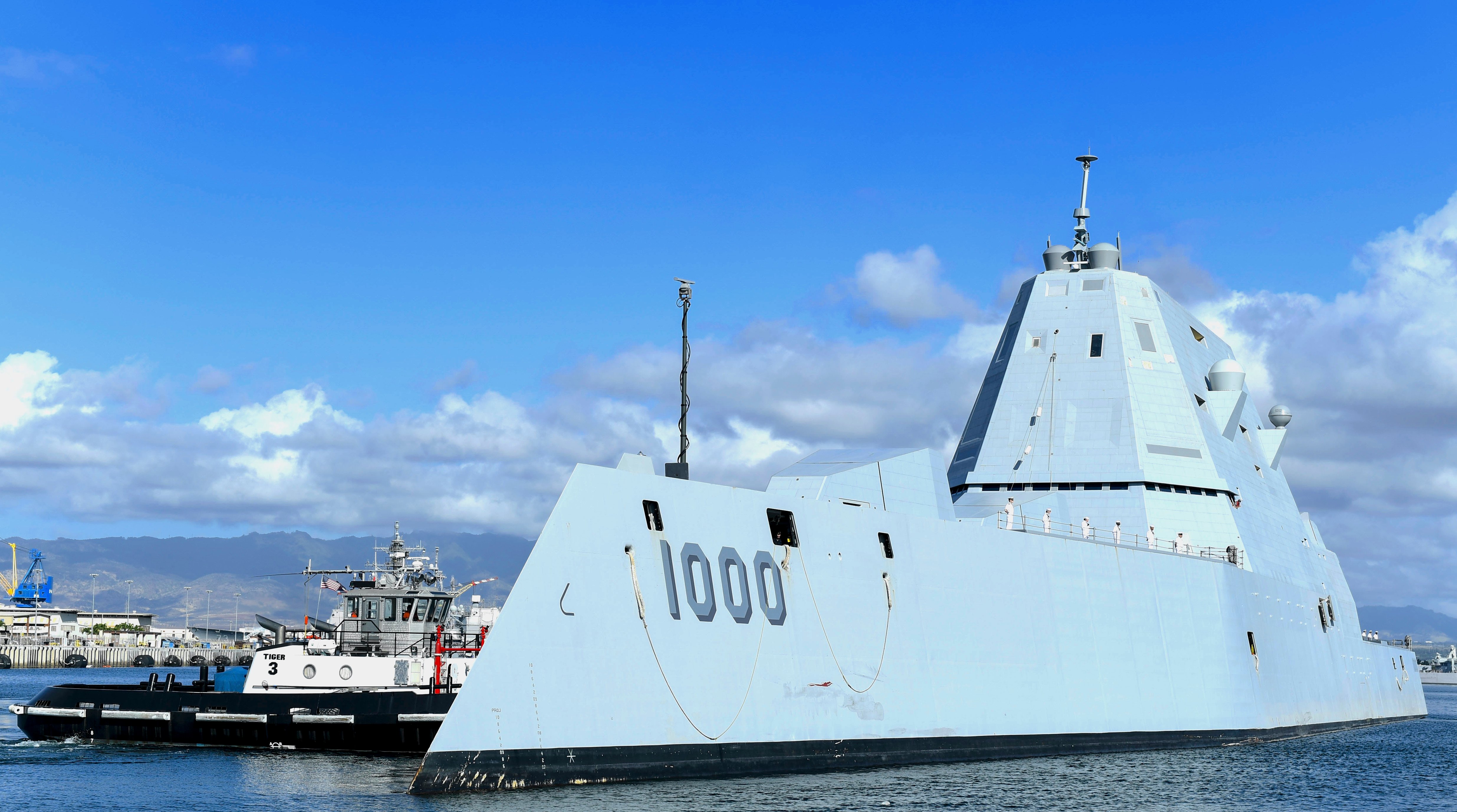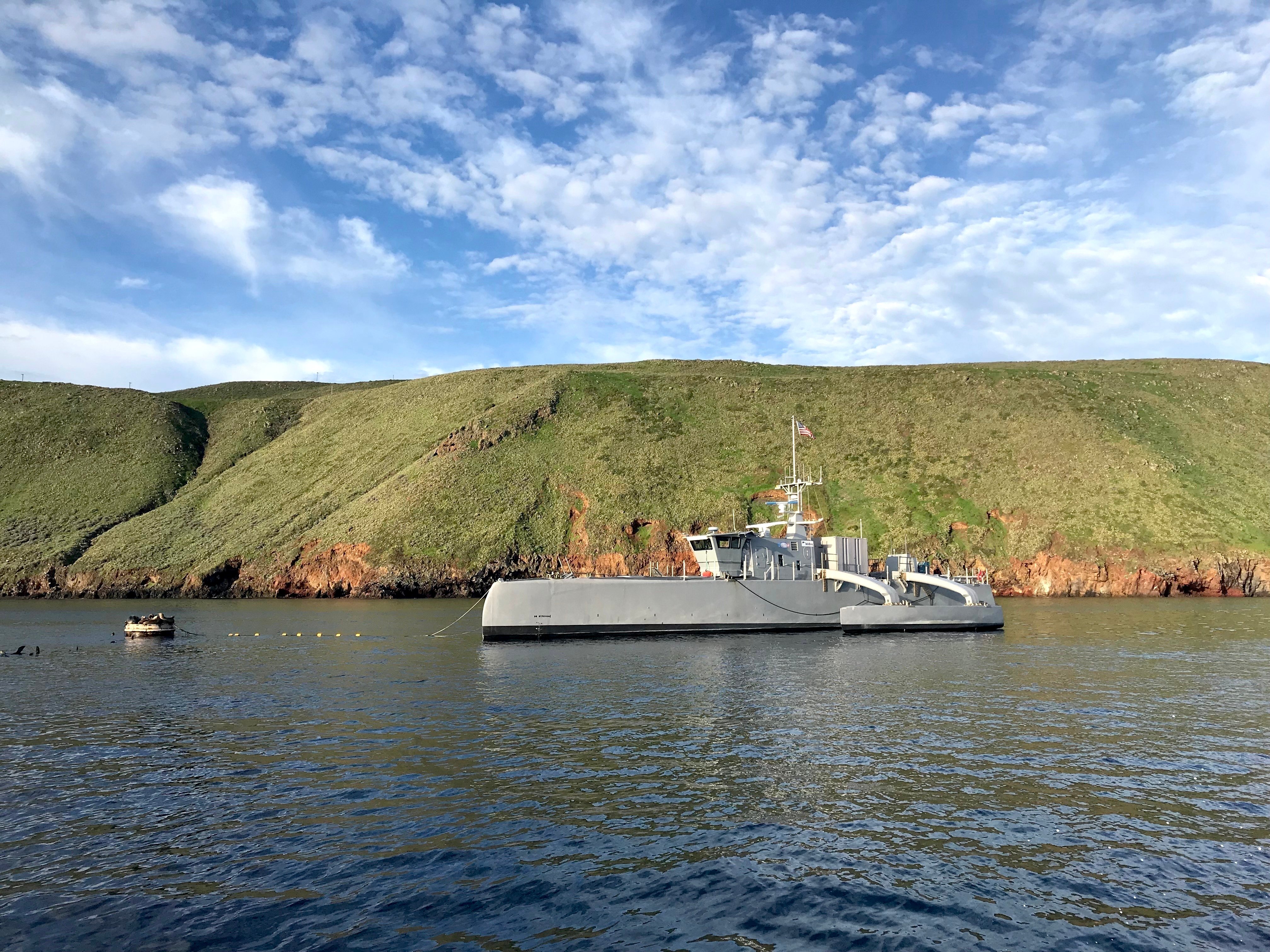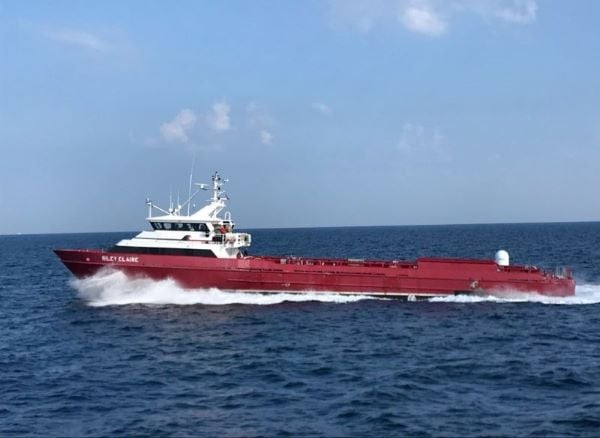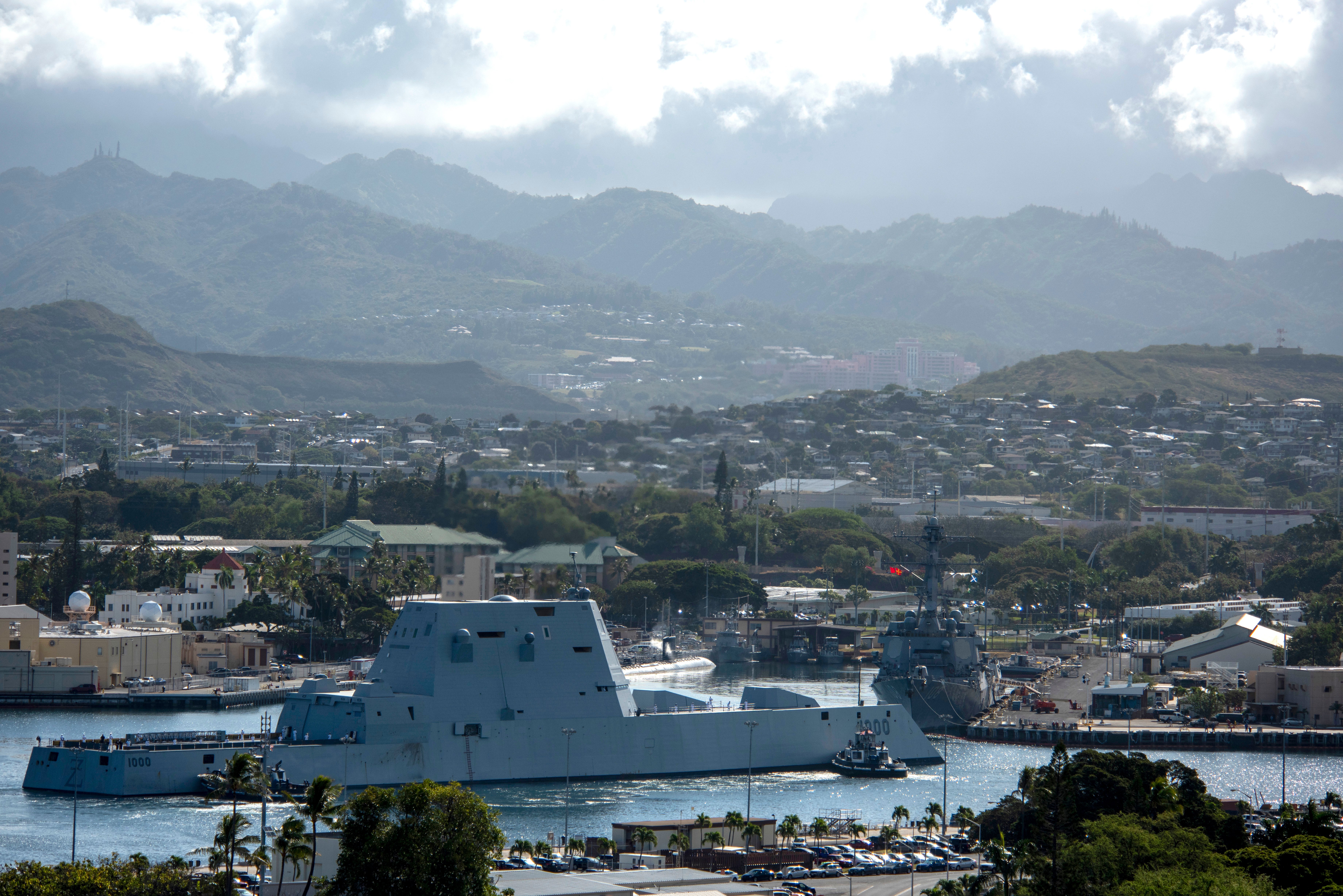
One year after the stand-up of the Navy’s development group to test new concepts in surface warfare, the command is prepared to make the most of an upcoming overlap in unmanned surface vessel (USV) experimentation and acquisition during its next year, the commodore of the unit told USNI News.
Surface Development Squadron One (SURFDEVRON) was stood up on May 22, 2019, and SURFDEVRON Commodore Capt. Hank Adams said that if the first year was all about planning and organizing, the second year will be all about shifting focus to in-water fleet familiarization and experimentation.
Now, Adams said in a recent interview with USNI News, the squadron has just three ships under its control: USS Zumwalt (DDG-1000), USS Michael Monsoor (DDG-1001) and medium USV Sea Hunter 1. Over the next year, though, the squadron will go from one to four USV prototypes, in “a dramatic expansion in our stable of USVs.”
The Sea Hunter 2 vessel will deliver in the second quarter of Fiscal Year 2021, or early in calendar year 2021, and two Overlord large USVs will move from Pentagon-level custody to the SURFDEVRON by the end of FY 2021. By the end of FY 2023, if current plans hold, four more large USV prototypes and the first program-of-record Medium USV (MUSV) would deliver, bringing the total to nine.
“What are you going to use these for? Some people have asked, why do you need so many? Why so many different flavors? And the answer is, it’s a concerted prototyping effort to inform what’s ultimately going to be the program of record for medium and large USVs, which is an integral part of the future surface combatant force and the future fleet design,” Adams said.
On the one hand, the Navy as a whole has quite a bit of experience with unmanned systems, with the submarine and aviation communities already farther along with operating their own unmanned systems. But USVs are new – and, unlike the unmanned aerial and underwater vessels the Navy already operates, the service wants to use the LUSV as an adjunct magazine to fire missiles remotely – so many questions remain on how to safely and effectively employ them. With a desire to quickly buy and field these vessels to help the Navy move to its future vision of operations that relies more on small and unmanned surface ships and less on big combatants like destroyers and cruisers, Adams said the pressure is on to make the most out of the next couple years before the MUSV and LUSV programs switch from prototype to program of record.
“There’s a lot of anticipation and demand from the fleet to begin using the one USV that we’ve got to start answering fleet-level questions,” such as how to think about manning, maintenance, training, operations, command and control, concepts of operations and more, he said.
Fleet Familiarization and CONOPS Development

SURFDEVRON has just one unmanned vessel under its control today, and that Sea Hunter 1 craft is mostly finishing up its previously scheduled obligations with its former owner, the Office of Naval Research, to conduct testing related to autonomy and safety. In the coming months, that schedule will wind down – so when Sea Hunter 2 delivers, SURFDEVRON will have two MUSVs to use as it sees fit to wring out an initial concept of operations document and get the fleet comfortable with working alongside a USV.
Adams said he has looked for opportunities this past year to squeeze fleet experimentation and familiarization events into the Sea Hunter 1 schedule in between ONR events, with the biggest win so far being including Sea Hunter 1 in the Nimitz Carrier Strike Group’s surface warfare advanced tactical training (SWATT) exercise in January.
After giving some very basic training to the destroyer squadron and ship crews, Adams said, the SURFDEVRON “said, hey, over to you; incorporate this into your tactical plan. And I gotta tell you, it was incredibly gratifying and exciting to see how energized the sailors on the ships – and I’m talking specifically the tactical watch standers, the guys and gals on the ship whose job it is to plan and execute tactical operations at the unit level. … By the same token, the planners and the watch standers on the squadron staff, it’s like somebody lifted the lid off the cookie jar. There was this new capability: they had heard about unmanned systems coming, and here we were presenting them with basically 72 hours of run time to just go experiment. The sum total of my guidance to the commanding officer who I gave tactical control of Sea Hunter to was, go think about how you want to employ this system, and just keep it safe.”
The SURFDEVRON staff gained feedback from the junior surface warfare officers who were allowed to control the Sea Hunter, which will be used to continue to refine the man/machine interface and ensure the system is intuitive to use.
“There were multiple levels of value and feedback, from tactical employment to command and control, operational interface, just to actually maneuvering Sea Hunter in the exercise battle space in and amongst other ships. And while it was a limited event in terms of sort of the grandness of the scale, it was us dipping our toe in the water for the first time, and I think it was very successful,” the commodore said.
SURFDEVRON will send Sea Hunter 1 to another training event this summer, though he could not elaborate on which carrier or amphibious group it would train with and when for security reasons.
“We’re still very much in the phase of, let’s just expose the fleet to it and see what they come back with,” Adams said.
“Every single touchpoint we have with the fleet is something that’s going to be a nugget that we seek to roll into the [concept of operations.”
The SURFDEVRON originally owed Naval Surface Force Pacific an initial CONOPS document by September, though that has been pushed back to November due to COVID-19 restrictions that are keeping personnel away from the classified spaces they need to work on this first best guess at how the MUSV and LUSV would be employed by the fleet.
“The CONOP is going to largely be an assertion. And then we’re going to go out and test it. That CONOP is going to represent sort of an initial theory by the fleet – very highly informed by internal studies and our knowledge of the systems,” Adams said, adding that the mission packages the MUSV and LUSV will carry are known entities but that the autonomy piece is new.
“It represents an assertion for how the surface unmanned systems are going to be employed, how they’re going to be maintained, for the utility of the fleet. And then we’re going to use the prototyping effort, which I would argue starts really in earnest in FY 21, because that’s when the numbers begin showing up – we’re going to use that prototyping effort in part to validate the assertions and assumptions in that CONOPS so that future iterations of the CONOP become more relevant, more accurate, and more useful to the fleet.”

Among the big questions that remain includes, how will the USVs and their operators deploy?
“What’s the modality for deployment? Is it detachments? Is it something else? Is it forward basing? Is it something else? These are all things we will seek to answer in this initial CONOPS we’re going to deliver towards the end of the year,” Adams said.
“Once you get into the unmanned world and all you really need to command and control an unmanned system is an app on a computer … you can really do that from anywhere. So the question is, where is the right place to do it based on the mission, the payloads – certainly any USV that has weapons on it has a completely different, more, frankly, conservative calculus for command and control than one that does not,” he said, and that’s all still being worked out in this first iteration of CONOPS development.
Adams stressed that that was the impetus for the Navy to continue to invest in buying prototypes beyond the two MUSV and two LUSV prototypes already in the water today: if program-of-record MUSVs start showing up on the waterfront in FY 2023, and program-of-record LUSVs start showing up in FY 2025, the Navy needs to already know what to do with them based on not only modeling but also in-water validation. Adams said the goal was to put out the initial CONOPS this fall and then refresh them at least once a year for the next couple years, wringing out any remaining issues by the time the fleet is ready to send these vessels forward to operate overseas.
Mirroring the undersea warfare community, Adams said he hoped to stand up a USV Division 1 organization under his command that would have direct ownership of the USVs for both experimentation and eventually operations. That organization is being planned now and would hopefully be formally established in FY 2022.
Also on tap for the coming year is settling on a home for the USVs and the eventual USV Division 1 staff, which Adams said he expected to finalize in the next two or three months. At the end of summer or early fall he also expects to have completed the first iteration of a USV operator training course. And he’s working with the Tactical Training Group Pacific (TACTRAGRUPAC) and Carrier Strike Group 15 to look at ways to integrate MUSVs and LUSVs into simulated training environments.
While he wants to do as much as he can with the two Sea Hunter MUSVs and eventually the two Overlord LUSVs in a live environment, he said it’s important to scale up and further increase fleet familiarization and innovating thinking efforts because “what guys like me in the program think the USVs are going to be good for, and the actual people who get the tool in their toolbox might come up with something totally different, so I’m very keen to gain fleet feedback as often and as early as possible.”
Zumwalt-class Destroyers

In addition to overseeing USV fleet integration and conducting at-sea experimentation to inform surface fleet tactics, SURFDEVRON also is the immediate superior in command for the three-ship Zumwalt class of destroyers.
Adams said the DDG-1000 program is still going through acquisition milestones that need to be met on time, but there’s also a need to do developmental work at sea in support of new CONOPS that reflect the ships’ new mission of surface strike and sea control operations instead of the former land-attack mission.
The commodore said his organization has grown in the past year and now is staffed with the right personnel to do more on the development side. When Zumwalt or Michael Monsoor are at sea for acquisition-related events, the staff could also make some progress on the developmental work to advance concepts and tactics and demonstrate capabilities associated with the ship now and into the future.
“There are plenty of questions that deserve answers about potential future uses of the ship in general, and then potential future use of other capabilities that may or may not exist onboard, to just get after them,” Adams said.
Zumwalt will reach initial operational capability in December 2021 and then begin some kind of training cycle ahead of being certified for global operations – though what that all looks like is still being worked out, Adams said.
“We are looking at all kinds of different modes of employing that ship. So whether or not she’s a rotational deployer, for example, or there’s some other model, I think that’s an open question, and that’s part of what we’re working with the fleet to get after. Whatever method we end up using – and I don’t think we’re necessarily locked into any one – it’s going to take advantage of all the capability that that class brings.”





